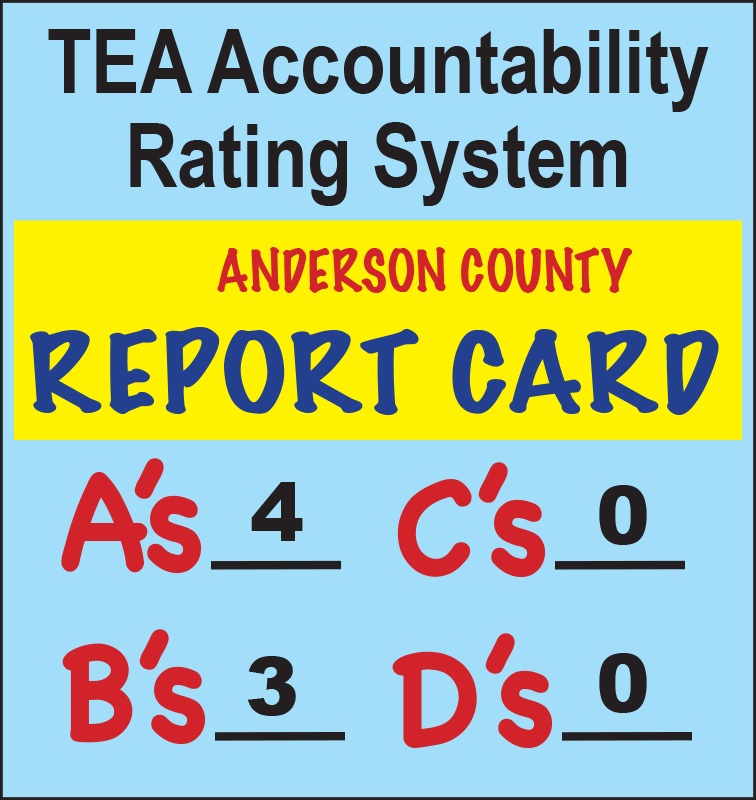School Accountability Grades are in for Anderson County

County Receives 4 A’s, 3 B’s
By Will Johnson
Messenger Reporter
EAST TEXAS – The wait is over for Texas school districts as the Texas Education Agency released its accountability grades for the 2018-2019 school year on Thursday, Aug. 15.
The latest and greatest school accountability system was established in 2017 by the 85th Texas Legislature with the passage of House Bill (HB) 22. Under HB 22, it was codified that public school districts would be measured on three domains to determine the academic performance of districts and campuses. The three domains set forth by the legislature were: student achievement, school progress and closing the gaps.
The legislation also called for districts and campuses to “… receive a rating of A, B, C, D, or F for overall performance, as well as for performance in each domain.”
During the 2018-2019 school year, there were 1,022 public school districts across the state of Texas. Of these 1,022 districts: 257 (25%) received an A; 622 (61%) received a B; 114 (11%) received a C; 21 (2%) received a D; six (> 1%) received an F; and two (>1%) were not rated.
For charter schools in the 2018-2019 school year, 179 schools were graded. The breakdown showed: 44 (25%) receiving an A; 55 (31%) receiving a B; 40 (22%) receiving a C; 22 (12%) receiving a D; 8 (4%) receiving an F; and 10 (6%) were not rated.
Locally, of the 12 school districts located Houston and Anderson Counties, five received an A, six received a B and one received a C.
In Anderson County, Cayuga ISD received an A as the district recorded an overall score of 94 out of a 100 point scoring system. The score indicates how well a district has prepared students for success, both in school and after high school in college, a career, or the military.
Concerning the score, the TEA states, “Districts or schools earn an A (90–100) for exemplary performance when they serve most students well, encouraging high academic achievement and/or appropriate academic growth for almost all students. Most students will be prepared for eventual success in college, a career, or the military.”
The three domains used to arrive at the score saw CISD record a 93 in student achievement, a 92 in school progress and a 96 on closing the gap.
According to the TEA website, “Student achievement shows how much students know and are able to do at the end of the school year. School progress shows how students perform over time and how that growth compares to similar schools, while the closing the gaps domain tells us how well different populations of students in a district are performing.”
The overall score is arrived at by determining the better grade between student achievement and school progress. This score is weighted as 70% of the overall grade. Next, the closing the gap score is weighted at 30%. These two scores are added together in order to determine the overall score.
In the case of CISD, the district received a 93 on student achievement compared to a 92 in school progress. So, using the 93 student achievement score weighted at 70%, CISD received 65.1 points. The closing the gaps score of 96 – weighted at 30% – gave the district 28.8 points. The combined total resulted in a rounded score of 94.
It should be noted, CISD increased its score from the 2017-2018 school year by 10 points.
Elkhart ISD showed a major jump in its score as it went from a B (80) in the 2017-2018 school year to an A in the 2018-2019 school year with a score of 90.
Concerning the score, the TEA states, “Districts or schools earn an A (90–100) for exemplary performance when they serve most students well, encouraging high academic achievement and/or appropriate academic growth for almost all students. Most students will be prepared for eventual success in college, a career, or the military.”
The three domains used to arrive at the score saw EISD record a 92 in student achievement, a 91 in school progress and an 85 on closing the gap.
In the case of EISD, the district received a 92 in student achievement compared to a 91 in school progress. So, using the 92 student achievement score weighted at 70%, EISD received 64.4 points. The closing the gaps score of 85 – weighted at 30% – earned the district 25.5 points. The combined total resulted in a rounded score of 90.
Frankston ISD increased its score as it went from an 81 in the 2017-2018 school year to an 89 in the 2018-2019 school year, maintaining its grade of B from the previous year.
Concerning the score, the TEA states, “Districts or schools earn a B (80–89) for recognized performance when they serve many students well, encouraging high academic achievement and/or appropriate academic growth for most students.”
The three domains used to arrive at the score saw FISD record a 91 in student achievement, a 91 in school progress and an 84 on closing the gap.
In the case of FISD, the district could use either the 91 in student achievement or the 91 in school progress. Regardless, using the 91 score weighted at 70%, FISD received 63.7 points. The closing the gaps score of 84 – weighted at 30% – earned the district 25.2 points. The combined total resulted in a rounded score of 89.
Neches ISD also showed an increase in its score as it went from a B (89) in the 2017-2018 school year to an A in the 2018-2019 school year with a score of 91.
Concerning the score, the TEA states, “Districts or schools earn an A (90–100) for exemplary performance when they serve most students well, encouraging high academic achievement and/or appropriate academic growth for almost all students. Most students will be prepared for eventual success in college, a career, or the military.”
The three domains used to arrive at the score saw NISD record a 93 in student achievement, a 93 in school progress and an 86 on closing the gap.
In the case of NISD, the district could use either the 93 in student achievement or the 93 in school progress. Regardless, using the score of 93, weighted at 70%, NISD received 65.1 points. The closing the gaps score of 86 – weighted at 30% – earned the district 25.8 points. The combined total resulted in a rounded score of 91.
Palestine ISD increased its score as it went from an 82 in the 2017-2018 school year to an 87 in the 2018-2019 school year, maintaining its grade of B from the previous year.
Concerning the score, the TEA states, “Districts or schools earn a B (80–89) for recognized performance when they serve many students well, encouraging high academic achievement and/or appropriate academic growth for most students.”
The three domains used to arrive at the score saw PISD record an 86 in student achievement, a 91 in school progress and a 79 on closing the gap.
In the case of PISD, the district received a 91 in school progress compared to an 86 in student achievement. So, using the 91 school progress score weighted at 70%, PISD received 63.7 points. The closing the gaps score of 79 – weighted at 30% – earned the district 23.7 points. The combined total resulted in a rounded score of 87.
Slocum ISD also showed an upwards move as it went from a B (89) in the 2017-2018 school year to an A in the 2018-2019 school year with a score of 91.
Concerning the score, the TEA states, “Districts or schools earn an A (90–100) for exemplary performance when they serve most students well, encouraging high academic achievement and/or appropriate academic growth for almost all students. Most students will be prepared for eventual success in college, a career, or the military.”
The three domains used to arrive at the score saw Slocum ISD record a 93 in student achievement, a 92 in school progress and an 87 on closing the gap.
In the case of Slocum ISD, the district received a 93 on student achievement compared to a 92 in school progress. So, using the 93 student achievement score weighted at 70%, Slocum ISD received 65.1 points. The closing the gaps score of 87 – weighted at 30% – earned the district 26.1 points. The combined total resulted in a rounded score of 91.
Rounding out the Anderson County school districts, Westwood ISD also showed improvement as it went from a C (78) in the 2017-2018 school year to a B in the 2018-2019 school year with a score of 81.
Concerning the score, the TEA states, “Districts or schools earn a B (80–89) for recognized performance when they serve many students well, encouraging high academic achievement and/or appropriate academic growth for most students.”
The three domains used to arrive at the score saw Westwood ISD record an 83 in student achievement, an 85 in school progress and a 73 on closing the gap.
In the case of Westwood ISD, the district received an 83 on student achievement compared to an 85 in school progress. So, using the 85 school progress score weighted at 70%, Westwood ISD received 59.5 points. The closing the gaps score of 73 – weighted at 30% – earned the district 21.9 points. The combined total resulted in a rounded score of 81.
Will Johnson may be contacted via e-mail at [email protected].






